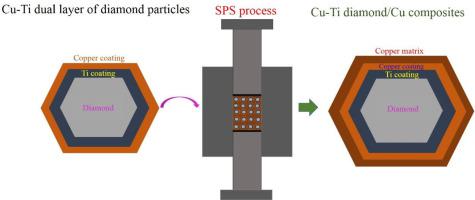当前位置:
X-MOL 学术
›
Diam. Relat. Mater.
›
论文详情
Our official English website, www.x-mol.net, welcomes your
feedback! (Note: you will need to create a separate account there.)
Microstructure and thermo-physical properties of Cu-Ti double-layer coated diamond/Cu composites fabricated by spark plasma sintering
Diamond and Related Materials ( IF 4.3 ) Pub Date : 2020-11-01 , DOI: 10.1016/j.diamond.2020.108041 Changrui Wang , Hongzhao Li , Minghe Chen , Zhiyou Li , Lina Tang
Diamond and Related Materials ( IF 4.3 ) Pub Date : 2020-11-01 , DOI: 10.1016/j.diamond.2020.108041 Changrui Wang , Hongzhao Li , Minghe Chen , Zhiyou Li , Lina Tang

|
Abstract Diamond/Cu composites were fabricated by spark plasma sintering (SPS) process with Cu Ti double-layer coated on the surface of diamond particles as the reinforcement phase. The effect of sintering temperature, pressure and holding time on the microstructure and thermo-physical properties of the composites were investigated. The results showed that the interface between diamond and copper matrix were tightly bonded with the increase of sintering temperature, the fracture surface morphologies were consisted of ductile fracture on copper matrix and diamond particles falling out from the bonding interface. As the double-layer coated on the surface of diamond particles made the interface present tightly bonding, which improved the interfacial bonding between diamond and copper matrix. It was found that the temperature, pressure and holding time together can accelerate the densification process and further improve the thermo-physical of the composites. Comprehensive consideration of process parameters, the process parameters conducive to strengthening the interface bonding are 900 °C, 60 MPa and 40 min, and the relative density, bending strength, hardness and thermal conductivity of Cu Ti double-layer coated diamond/Cu composites were 99.77%, 153.52 MPa, 148.63 HV and 258.04 W/m·K, respectively. Moreover, higher sintering temperature, larger pressure and longer holding time could cause copper matrix to melt and grain growth as well as the graphitization of diamond, which reduced the densification and lowered the thermo-physical of the composites.
中文翻译:

放电等离子烧结法制备Cu-Ti双层涂层金刚石/Cu复合材料的显微组织和热物理性能
摘要 采用放电等离子烧结(SPS)工艺制备金刚石/铜复合材料,以金刚石颗粒表面包覆双层铜钛为增强相。研究了烧结温度、压力和保温时间对复合材料微观结构和热物理性能的影响。结果表明,随着烧结温度的升高,金刚石与铜基体的界面结合紧密,断口形貌为铜基体韧性断裂,金刚石颗粒从结合界面脱落。由于金刚石颗粒表面的双层包覆使界面呈现紧密结合,从而改善了金刚石与铜基体之间的界面结合。结果发现,温度 压力和保压时间一起可以加速致密化过程并进一步改善复合材料的热物理。综合考虑工艺参数,有利于强化界面结合的工艺参数为900℃、60 MPa、40 min,Cu Ti双层涂层金刚石/Cu复合材料的相对密度、弯曲强度、硬度和导热系数分别为分别为 99.77%、153.52 MPa、148.63 HV 和 258.04 W/m·K。此外,较高的烧结温度、较大的压力和较长的保温时间会导致铜基体熔化和晶粒长大以及金刚石的石墨化,从而降低了复合材料的致密化和热物理性能。综合考虑工艺参数,有利于强化界面结合的工艺参数为900℃、60 MPa、40 min,Cu Ti双层涂层金刚石/Cu复合材料的相对密度、弯曲强度、硬度和导热系数分别为分别为 99.77%、153.52 MPa、148.63 HV 和 258.04 W/m·K。此外,较高的烧结温度、较大的压力和较长的保温时间会导致铜基体熔化和晶粒长大以及金刚石的石墨化,从而降低了复合材料的致密化和热物理性能。综合考虑工艺参数,有利于强化界面结合的工艺参数为900℃、60 MPa、40 min,Cu Ti双层涂层金刚石/Cu复合材料的相对密度、弯曲强度、硬度和导热系数分别为分别为 99.77%、153.52 MPa、148.63 HV 和 258.04 W/m·K。此外,较高的烧结温度、较大的压力和较长的保温时间会导致铜基体熔化和晶粒长大以及金刚石的石墨化,从而降低了复合材料的致密化和热物理性能。Cu Ti双层涂层金刚石/Cu复合材料的硬度和导热系数分别为99.77%、153.52 MPa、148.63 HV和258.04 W/m·K。此外,较高的烧结温度、较大的压力和较长的保温时间会导致铜基体熔化和晶粒长大以及金刚石的石墨化,从而降低了复合材料的致密化和热物理性能。Cu Ti双层涂层金刚石/Cu复合材料的硬度和导热系数分别为99.77%、153.52 MPa、148.63 HV和258.04 W/m·K。此外,较高的烧结温度、较大的压力和较长的保温时间会导致铜基体熔化和晶粒长大以及金刚石的石墨化,从而降低了复合材料的致密化和热物理性能。
更新日期:2020-11-01
中文翻译:

放电等离子烧结法制备Cu-Ti双层涂层金刚石/Cu复合材料的显微组织和热物理性能
摘要 采用放电等离子烧结(SPS)工艺制备金刚石/铜复合材料,以金刚石颗粒表面包覆双层铜钛为增强相。研究了烧结温度、压力和保温时间对复合材料微观结构和热物理性能的影响。结果表明,随着烧结温度的升高,金刚石与铜基体的界面结合紧密,断口形貌为铜基体韧性断裂,金刚石颗粒从结合界面脱落。由于金刚石颗粒表面的双层包覆使界面呈现紧密结合,从而改善了金刚石与铜基体之间的界面结合。结果发现,温度 压力和保压时间一起可以加速致密化过程并进一步改善复合材料的热物理。综合考虑工艺参数,有利于强化界面结合的工艺参数为900℃、60 MPa、40 min,Cu Ti双层涂层金刚石/Cu复合材料的相对密度、弯曲强度、硬度和导热系数分别为分别为 99.77%、153.52 MPa、148.63 HV 和 258.04 W/m·K。此外,较高的烧结温度、较大的压力和较长的保温时间会导致铜基体熔化和晶粒长大以及金刚石的石墨化,从而降低了复合材料的致密化和热物理性能。综合考虑工艺参数,有利于强化界面结合的工艺参数为900℃、60 MPa、40 min,Cu Ti双层涂层金刚石/Cu复合材料的相对密度、弯曲强度、硬度和导热系数分别为分别为 99.77%、153.52 MPa、148.63 HV 和 258.04 W/m·K。此外,较高的烧结温度、较大的压力和较长的保温时间会导致铜基体熔化和晶粒长大以及金刚石的石墨化,从而降低了复合材料的致密化和热物理性能。综合考虑工艺参数,有利于强化界面结合的工艺参数为900℃、60 MPa、40 min,Cu Ti双层涂层金刚石/Cu复合材料的相对密度、弯曲强度、硬度和导热系数分别为分别为 99.77%、153.52 MPa、148.63 HV 和 258.04 W/m·K。此外,较高的烧结温度、较大的压力和较长的保温时间会导致铜基体熔化和晶粒长大以及金刚石的石墨化,从而降低了复合材料的致密化和热物理性能。Cu Ti双层涂层金刚石/Cu复合材料的硬度和导热系数分别为99.77%、153.52 MPa、148.63 HV和258.04 W/m·K。此外,较高的烧结温度、较大的压力和较长的保温时间会导致铜基体熔化和晶粒长大以及金刚石的石墨化,从而降低了复合材料的致密化和热物理性能。Cu Ti双层涂层金刚石/Cu复合材料的硬度和导热系数分别为99.77%、153.52 MPa、148.63 HV和258.04 W/m·K。此外,较高的烧结温度、较大的压力和较长的保温时间会导致铜基体熔化和晶粒长大以及金刚石的石墨化,从而降低了复合材料的致密化和热物理性能。











































 京公网安备 11010802027423号
京公网安备 11010802027423号